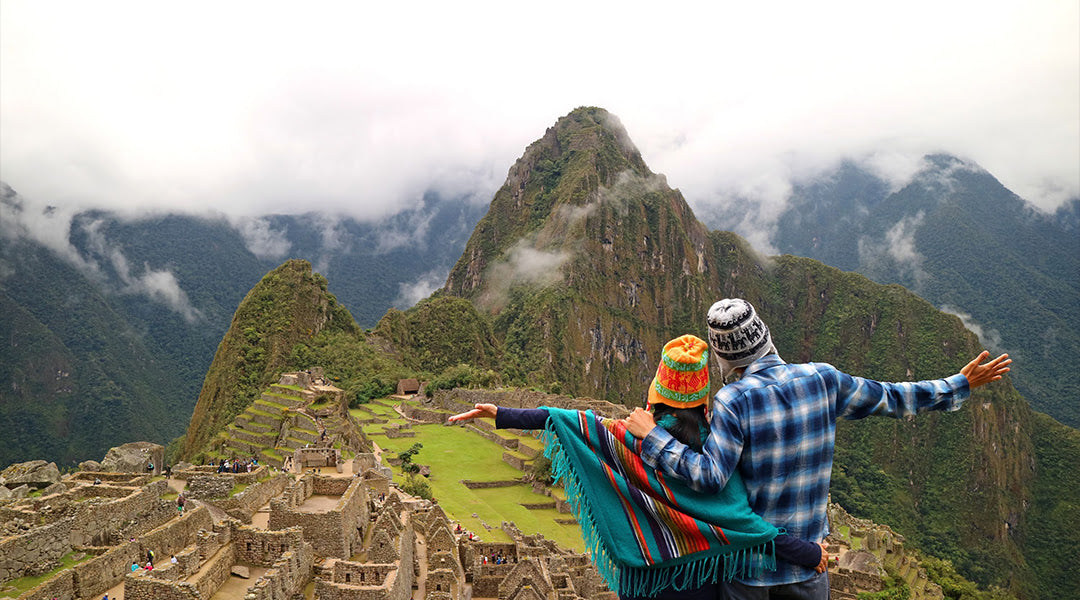
Peru’s Contribution To The Coffee Industry Sets The Stage For Sustainability
Machu Picchu, the Andes Mountains, Lake Titicaca, the Amazon River, and the Amazon rainforest…what do each of these have in common? Each of these magnificent wonders are partially or wholly located in Peru.
But, as majestic as each of these are, could it be that something this country produces is even greater?
Peru is among the top countries in the world for coffee production, and while we’re certainly not claiming this commodity to rival ancient Incan civilizations or powerfully beautiful wonders such as the Amazon rainforest, what this country brings to the coffee table is truly amazing!
From a vast array of small, independent coffee plantations to an extensive variety of terrain, climate, and more, Peru produces some of the most unique and sought after coffee in the world, even setting the example globally for fair trade, organic, and sustainable farming practices.
So, today we’d like to explore Peru’s contributions to the coffee industry, and in doing so, you may be surprised to learn of the variety, quality, uniqueness, and impeccable standards this South American country has infused into coffee culture as we know it all throughout the world.
Coffee - Peru’s Primary Commodity

Peru is the third largest country in South America, and part of what makes their contribution to the coffee industry so unique comes down to their location and varied landscape.
Peru’s topography consists of a wide variety of landscapes including mountains, beaches, rainforests, and deserts. So, as you can imagine, such unique terrain means this country offers a variety of elevations, soils, and climates in which their coffee can be grown.
Actually, I’m not so sure the word variety is truly sufficient for describing Peru’s natural backdrop for growing coffee.
Due to the country’s location in respect to the Andes Mountains, Peru is home to hundreds of microclimates in the Andean region which allow for variations in altitude, humidity, sun exposure, and heat.
The Andes mountains, as far as coffee growing is concerned, even divide Peru into distinct growing regions, some in high elevations, some in low.
All of these factors combined have diversified the country’s coffee growing abilities, allowing Peru to produce some of the most unique flavor profiles in the world.
Of course, such distinctive offerings have made Peruvian coffee a highly sought after commodity amongst specialty roasters across the globe. And, this is likely why coffee is Peru’s main agricultural export, making up 25% of the country’s agricultural income.
Nearly a quarter of a million farmers in Peru depend upon the coffee industry for their livelihood, and more than two million Peruvians work within the industry in other ways.
Unfortunately, there are many challenges that face Peruvian coffee farmers, making their mark on the coffee world a hard-fought one.
Many of Peru’s coffee farms are owned and operated by small families, and while this is great for quality (more on that in a moment), this can also create hardship for families when it comes to being able to effectively process and store their high-quality coffee cherries.
Most small plantations grow, harvest by hand, wash, and process their own coffee cherries, though finances and locale make it difficult to store beans.
So, farmers must travel either on foot or by mule to larger towns and villages where the coffee can be exported.
And, due to the distance between coffee farms and the coast, where export often occurs, farmers may mix and trade their beans multiple times before reaching this destination.
Also due to a lack of ample storage, many farmers often must sell their harvest for a less than desirable wage.
All of these hurdles have certainly hindered some Peruvian coffee crops regarding consistency and quality. But, these circumstances have also prompted the intervention of Peru’s Ministry of Agriculture in setting up farming organizations to modernize and centralize production methods, all of which has resulted in the country producing higher quality coffee.
These interventions combined with a commitment to excellence amongst South American coffee farmers have led to Peru’s high (and growing higher) rank when it comes to global coffee standings and the way the industry has evolved.
Actually, you could say Peru’s organic growing practices now lead the world as a picture of what coffee farming can, will, and should be worldwide.
Organic Coffee - Peru’s Primary Passion

With concerns arising surrounding climate change and the effects of coffee growing practices on this detriment, Peru has become the world’s leader in the production of organic coffee.
Yet, despite this country’s vast contributions to the industry, much of its people have remained in poverty. So, to neglect sustainable farming methods would worsen the cycle of poverty to the possible point of no return.
Incorporating sustainable farming methods ensures that not only the planet is protected but the livelihoods of so many who depend upon the coffee industry for income are considered as well.
- Without the incorporation of sustainable coffee farming practices, forests are cleared causing damage to ecosystems both wildlife and farmers rely upon.
- Without sustainable coffee farming practices, those working within the coffee industry are exposed to harmful chemicals which greatly, negatively, affects their health and the health of our planet.
- Without sustainable coffee farming practices, rainforest regions are depleted affecting agricultural needs for much of the population as well as the industries relying upon these sources.

Recognizing this dire need for sustainability is what led Peruvian farmers to take action, and now they’re leading the world in producing certified fair trade, organic, sustainably grown Arabica coffee.
Since most coffee plantations in Peru are extremely small, operated oftentimes by single families, the way coffee is farmed here makes all the difference.
Because of the poverty that plagues these regions, farmers have a greater stake than simply producing great coffee when implementing these measures. Using sustainable growing practices means their business and way of life will continue, providing for these families throughout many generations.
This means the following practices rule coffee production within most small farms in Peru…
- utilizing biodiversity to enhance the growing practices and region
- negating the use of harsh chemicals in the growing process
- growing coffee at high elevations for varied flavor profiles, slow maturation, and greater nutrient content
- growing coffee plants amongst native plantlife in the region, negating deforestation
- growing, cultivating, and harvesting all crops by hand, protecting the region and producing only the best coffee cherries
These detailed, quality-conscious practices combined with the diverse growing regions and conditions have propelled Peru to the top of the charts when it comes to sustainably grown, high quality coffee.
And, now that we’ve seen the practices incorporated to achieve such greatness, let’s close out by examining Peru’s coffee product.
Save up to 48% and have the world's healthiest coffee delivered fresh to your door. Stay as long or as short as you like with absolutely no commitments.Join the Lifeboost Family

Peruvian Coffee - The World’s Enjoyment

Setting the stage and standard for great coffee, personally I see a template when viewing Peru’s coffee offerings to the world.
In fact, much of what coffee connoisseurs look for in a great cup is exemplified in Peruvian coffee.
So, as we conclude here today, let’s take a look at what makes Peruvian coffee some of the world’s most unique and wonderful java.
First, history. In the country’s coffee beginnings, much land, including coffee plantations, was owned by the wealthy elite of Europe. But, as workers migrated to these areas they saw great opportunities for independent work in the coffee industry.
This soon led to many small, independent, family coffee farms dotting the hillsides of Peru.
Today, 425,000 hectares within the country are farmed by small families.
And, while these endeavors aren’t without struggle economically speaking, these types of farms in Peru and around the world are proving that high quality coffee is only derived from the best practices…best for our planet, and best for our palate.

Second, practice. Somewhat overlapping what we mentioned above, the growing practices of small, family owned coffee farms look very different from large corporation owned farms where coffee is mass produced.
So, I wanted to essentially restate the importance of small coffee plantations for their contribution to both quality and the preservation of our planet.
Within small, independent coffee farms, this is where we greatly see the attention to detail in farming practices as well as the need and desire to protect the soil, biodiversity, and essentially the entire ecosystem these farmers both live in and depend upon for growing coffee (and thus providing for their families).
On these farms where organic Peruvian coffee is sustainably grown, it is the knowledge of farmers passed down through generations that know how to combat typical diseases that plague coffee plants as well as their skillful eyes searching for and selecting only the perfectly ripe cherries, without defect, for harvesting that make this country’s coffee so highly sought after.
And, of course, without the unique growing conditions present in Peru, the coffee produced here wouldn’t possess the tasting profiles so highly sought after within the industry.

As we mentioned earlier, Peru’s extensively diverse growing regions, from climate to terrain, altitude, and more all contribute to the unique flavor profile of the beans produced here.
If you’ve been a Lifeboost customer for very long, one thing you’ve likely grown accustomed to is our nutrient dense, smooth, high quality coffee beans. And, one of the reasons our beans stand out above the rest is due to the elevations at which our coffee is grown (in Nicaragua).
Much of Peruvian coffee is also grown at high elevations, and like Lifeboost coffee, this means such beans generally have a mild acidity, a medium body, and a smooth finish.
The shade provided by the Andes mountains also makes for exceptional growing conditions for coffee shrubs as this shields the plants from the hot sun allowing them to mature more slowly in the coolness of the shade.
Then, the tropical climate in Peru produces the right amount of rainfall for coffee plants, and this combined with sun exposure throughout the region creates a harmonious soil environment for the plants to fully thrive.

All of these factors combine allowing Peru to offer the world a diverse, complex selection of coffees grown over multiple regions throughout the country.
- The Coastal region has a mild and humid climate with low altitude plains. This region only accounts for 22% of Peru’s coffee production, but those coffees produced here are known for well-balanced flavors, often containing notes of chocolate, nuts, and caramel.
- The Sierra region is located in the center of the country and produces nearly 56% of Peru’s coffee. The Andes Mountains define this region, dictating its high altitudes and cooler temperatures (compared to the rest of the country).
Due to these elevations and temperatures, coffee matures more slowly in this region and has a bright acidity balanced out by a delicate sweetness.
- The Jungle region or the Amazon region, as you might have guessed, is located within the Amazon rainforest and has a warm and humid climate. Here, coffee can be sustainably grown amidst other plant life in the rainforest which provides a canopy of shade to combat the warm temperatures.
Coffee produced here is known for its notes of desiccated and dried fruit.

Overall, there are roughly eight types of coffee produced in Peru throughout the above-listed growing regions.
Caturra: This is a natural hybrid of Bourbon coffee first found in Brazil. Caturra coffees are well-balanced in sweetness and acidity, often containing bright citrus notes.
Catamor: This is a cross between Timor (a leaf rust resistant plant) and Caturra. It was first grown in Portugal and produces cherries quickly with high crop yields.
Catamor varieties typically have a mild sweetness and acidity, and with a bigger body than many varieties, Catimor has woody, earthy tasting notes.
Catuai: With a more classic flavor profile, Catuai possesses notes of chocolate with a sweetness like pure sugar cane. This variety has a medium acidity and is generally grown in high altitudes.
Mundo Novo: Also grown at high altitudes, the Mundo Novo varietal is a cross between Typica and Bourbon. Perfect for a deep, dark roast, this medium-bodied variety boasts a smooth finish, with woody undertones.

Typica: This Arabica coffee varietal doesn’t yield high amounts and it’s prone to many diseases which affect coffee plants, however, it produces a good quality cup. It’s considered to be a parent of both Mundo Novo and Pacamara.
Typica possesses elegant, complex flavors reminiscent of flowers and nuts, an all around sweet, clean cup.
Bourbon: Like Typica, the Bourbon variety is also highly susceptible to disease, but those cherries which are well managed by the skillful eyes of trained farmers produce one of the most excellent cups of coffee.
Grown at high altitudes, this variety is of exceptional quality and is classically known for its deep chocolate flavors, sweetness, and light fruit overtones.
Pache: This is a subvariety of Typica and generally must be grown at elevations of 3900 feet above sea level. In Peru, however, due to other factors like climate, this variety is grown at elevations above 4500 feet.
But, despite these elevations, Pache is highly acidic. With citrus undertones and a low bitterness, this variety produces a high quality cup that’s smooth and flat.

Pacamara: Known for its large bean size and incredible taste profile, Pacamara varieties grown in Peru often have sweet flavor notes ranging from that of butterscotch, cinnamon, and chocolate to raspberry and orange with jasmine undertones.
It boasts a full-medium body with a creamy texture that fans of this variety love.
Aside from these listed above, other varietals from Peru boast a range of complex flavors such as lush red wine, sparkling or bright citrus, and tropical fruit.
Now, if you’re familiar with any of the varieties listed above, it’s likely that you’ve seen them come out of regions and countries other than Peru as well. So then, what sets Peru apart?
What makes Peru the world’s top producer of organic coffee?
As we listed above, this country’s commitment to sustainability and organic, environmentally sound growing practices truly means everything when it comes to quality.
And, roasters worldwide have sought out Peru’s speciality grade, high quality, complex beans.
From their growing practices, varied growing regions, and unique flavor offerings, Peru has taken their place as a top producer in the industry of quality beans, setting the stage for sustainability, and delicious coffee, worldwide.
Delicious, Rare, Exotic Coffee, for True Connoisseurs
Organic Cajamarca Microlot
Check out Lifeboost Coffee Organic Cajamarca Microlot.

Becky is a mother, educator, and content writer for Lifeboost Coffee. She has had three years’ experience as a writer, and in that time she has enjoyed creatively composing articles and ebooks covering the topics of coffee, health and fitness, education, recipes, and relationships.
- https://www.visualcapitalist.com/worlds-top-coffee-producing-countries/
- https://www.atlascoffee.com/coffee/peru/#
- https://www.undp.org/facs/peru-sustainable-coffee#
- https://coffeehunter.com/our-origins/peru/#
- https://finalgrind.com/blogs/blog/peruvian-coffee-a-complete-guide#
- https://www.peru.travel/en/masperu/wonder-of-the-world-6-facts-you-didnt-know-about-peruvian-coffee#
- https://worldcoffeeresearch.org/focus-countries/peru
- https://www.tastingtable.com/931381/what-makes-peruvian-coffee-so-special/
- https://enjoyjava.com/peruvian-coffee/
- https://www.homegrounds.co/caturra-coffee/#
- https://www.homegrounds.co/catimor-coffee/#
- https://mahoganychocolates.com/products/catuai-natural-coffee#
- https://varieties.worldcoffeeresearch.org/varieties/mundo-novo
- https://kauaicoffee.com/blogs/news/meet-mundo-novo-coffee-1#
- https://perfectdailygrind.com/2020/04/the-typica-coffee-variety-what-is-it-why-is-it-so-important/
- https://varieties.worldcoffeeresearch.org/varieties/bourbon
- https://bourboncoffeeusa.com/coffees#
- https://brewlogy.com/beans/pache/#
- https://www.homegrounds.co/pacamara-coffee-beans/#
- https://fnb.coffee/blog/best-climate-for-growing-coffee/
- https://www.peruforless.com/blog/peruvian-coffee/#
- References for the article to confirm data and information.
Drop a Comment
I have ordered 6 bags twice from you and this is truly the best coffee ever! Nothing compares. No more heartburn or acid reflux! I love the dark roast and keep a glass pitcher of it in my refrigerator at all times if I am wanting a cold drink especially in the summer. South Dakota winters are cold so there is nothing better than a hot cup of Lifeboost coffee! After drinking this, I will never buy anything else! Thank you Lifeboost!!!










